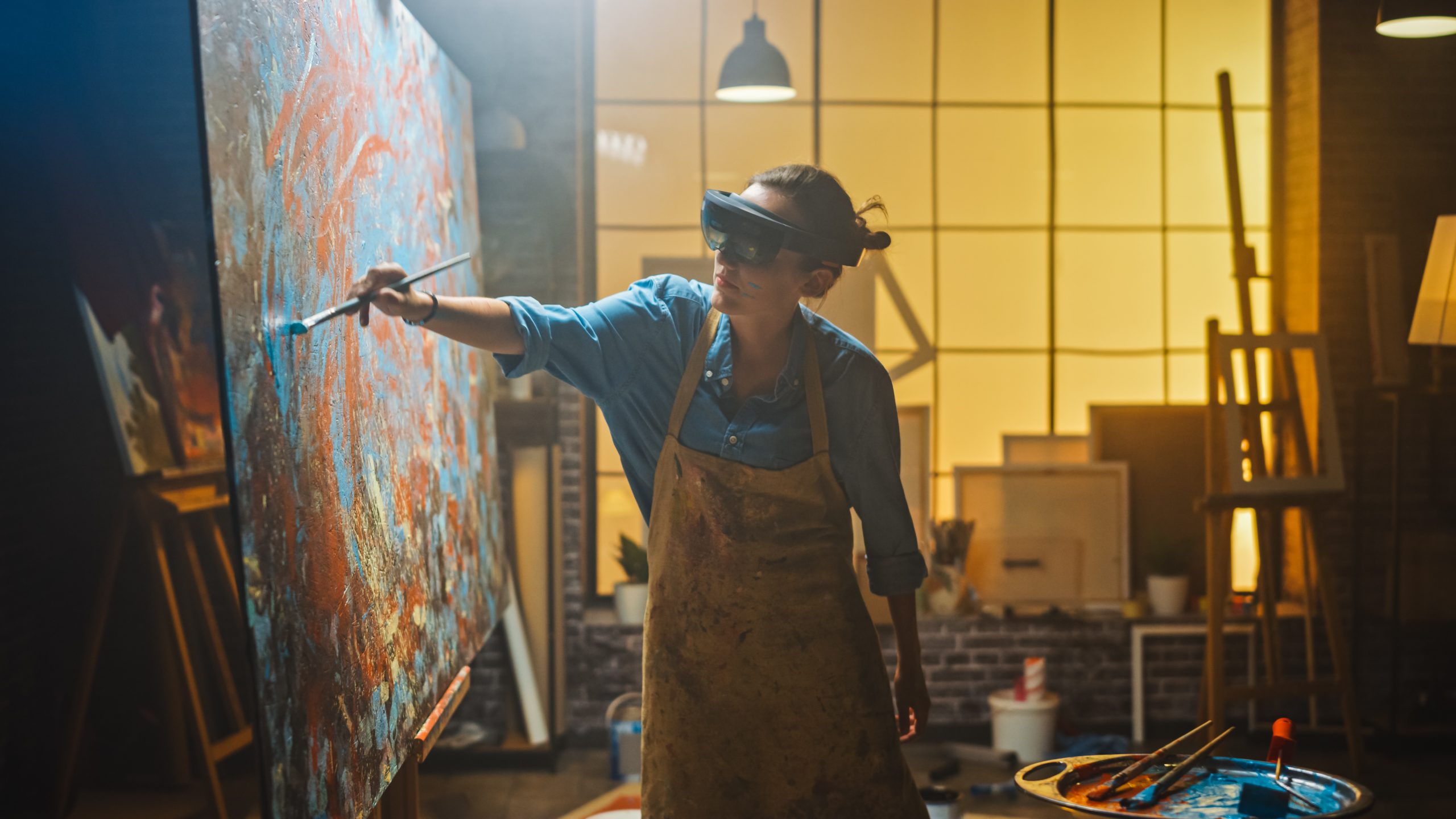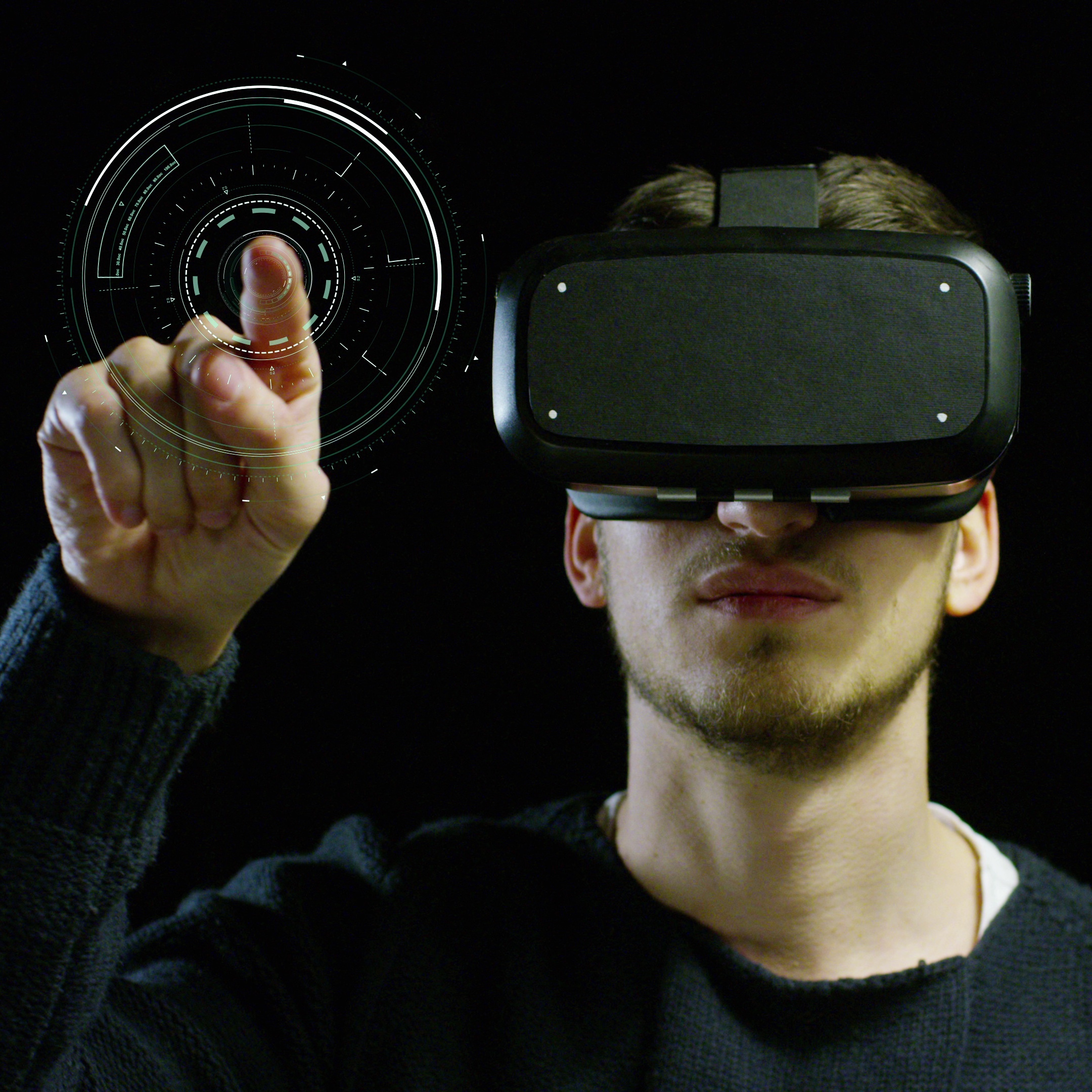AR art installations: Merging physical and virtual worlds
Augmented Reality art installations are transforming the creative landscape by merging physical and virtual worlds. Viewed through mobile devices, AR art turns static environments into dynamic, interactive experiences with animations and audio placed in specific spatial locations. This technology, driven by advancements and our digital-first world, is rapidly gaining traction.
In 2022, the AR market was valued at USD 32.1 billion and is expected to soar to USD 432.35 billion by 2031, reflecting significant investment and growing interest across various sectors.
AR art offers unique opportunities to reinterpret and enhance traditional artworks. Imagine placing a Van Gogh masterpiece in your living room (check out this video!) or viewing intricate digital sculptures in outdoor spaces. AR technology makes this possible, providing immersive and engaging ways to experience art.
This blog explores AR artworks, their growing importance in business contexts, and practical use cases. From real estate visualization to interactive retail experiences, AR art installations can revolutionize how businesses engage with their audiences. We’ll also highlight real-world examples, innovative experiments, and related technologies that can help you harness the power of AR for your business.
Stay tuned as we explore the fascinating world of AR art and discover how you can use this transformative technology to elevate your business experiences.
How Does AR Art Work?
AR art installations use mobile devices or headsets to create immersive experiences by overlaying digital elements onto the physical world. This blend of reality and virtuality transforms static spaces into dynamic, interactive environments.
In your audience’s hands:
Using a mobile app or any other AR-enabled device, viewers point their camera at a designated area, where AR “art” content appears as 3D objects. These elements jump to life on their device. These virtual elements can include animations, audio, and interactive features that respond to user actions.
Today, the AR experience can be elevated with AR wearables from brands like XReal, which has a range of AR glasses that allow a more seamless, unobstructed, and believable experience because viewers aren’t looking at the augmented scene through a screen anymore. Watch this space for more action in the coming months. Snapchat has models for sale, too, and Jio Tesseract and other brands might be joining the fray soon.
Behind the scenes:
Creating AR art involves several key steps:
- Conceptualization:
Artists develop a concept that integrates digital elements with the physical world, adding layers of meaning and interaction.
- 3D Modeling and Animation:
Tools like Blender and Autodesk Maya help design lifelike AR art models seamlessly blending with the environment.
- Development Platforms:
Unity and Unreal Engine are used to develop AR experiences, ensuring virtual elements interact harmoniously with the physical space.
- Spatial Mapping:
Tools scan the environment to guide the placement of virtual elements, ensuring they align correctly and enhance the immersive experience.
- Testing and Refinement:
The AR artwork is rigorously tested and refined to ensure smooth interaction between physical and virtual elements.
In your hands:
AR art is highly accessible, typically requiring only a smartphone or tablet. This makes it easy for you to serve it to your target audience in various settings, from museums and galleries to public spaces and even their own homes and offices. As a result, you can leverage AR art installations to create unique, interactive experiences that captivate and engage their audiences.
Why AR Art Installations Matter: Engaging Customers Like Never Before
AR art installations offer more than just a novel experience—they present significant opportunities to engage various stakeholder groups innovatively, enhance experiences, and stay ahead in a digital world.
Enhanced Engagement and Interaction
AR art adds layers of form, motion, and meaning to static artworks, transforming passive viewers into active participants. AR-enhanced murals and sculptures invite interaction, triggering animations or revealing hidden stories, making experiences more memorable and impactful.
Accessibility and Cost-Effectiveness
Unlike Virtual Reality, AR is more accessible and cost-effective. Most AR experiences can be accessed via smartphones or tablets, making engaging a broader audience easier. This lower barrier to entry also reduces production costs, making AR a viable option for various applications.
Versatile Applications Across Industries
AR scanning technology can be leveraged across numerous industries:
- Real Estate: Potential buyers can virtually walk through properties, enhancing decision-making.
- Retail: Virtual try-on experiences help customers make informed purchases.
- Museums and Galleries: Interactive elements enrich educational value and visitor engagement.
- Manufacturing and Industry 4.0: Smart factory applications provide real-time information and maintenance support. Imagine scanning equipment with a smartphone or tablet (with the associated AR scanning app) to get these details in real time.
Future-Proofing Your Business
As AR technology evolves, early adopters will capitalize on emerging trends. AR’s ability to create hyper-personalized, immersive experiences sets businesses apart and appeals to tech-savvy consumers.
Real-World Examples and Success Stories
- Google’s AR-T Project: Brings famous artworks to life through AR, making them more accessible and engaging.
- The Enemy by Karim Ben Khelifa: Places viewers amid conflicts, creating empathetic and educational experiences.
5 Easy-to-Apply Business Use Cases of AR Scanning
Augmented Reality scanning can be a game-changer across various industries, offering innovative ways to engage customers, enhance experiences, and streamline operations. Here are five practical business use cases for AR scanning:
- Real Estate Visualization
How it works:
Real estate companies can use AR scanning to provide potential buyers with detailed virtual representations of properties. By scanning a photo or a QR code, users can view 3D models of homes, explore different interior design options, and even see how furniture fits in the space. This immersive experience helps buyers visualize properties better and make informed decisions.
Example worth emulating:
HomeJab uses AR to showcase real estate projects vividly, offering ideas on furnishing and interior design through virtual tours.
See how it would work in these illustrative videos:
1) Augmented Reality Real Estate Video | Yeppar
2) Augmented Reality for Real Estate | AR for Interior design | Augmented Reality
Benefits:
- Enhances buyer engagement and interest.
- Reduces the need for physical visits.
- Provides a competitive edge in marketing properties.
- Virtual Try-On
How it works:
AR scanning enables customers to try on products such as clothing, accessories, or eyewear virtually. By scanning a product image, customers can see how items look on them in real-time, making the shopping experience more interactive and fun.
Examples worth emulating:
- 1) Lenskart’s AR try-on feature allows users to compare looks and find the perfect pair of glasses without visiting a store.
- 2) Wanna Kicks – Explore new sneakers in AR that might seem like a gimmick or a fad, but before you dismiss the idea, consider the fact that Google has invested in developing this technology.
Benefits:
- Reduces return rates by helping customers make better purchase decisions.
- Increases online shopping engagement.
- Offers a personalized shopping experience.
- Interactive Product Manuals
How it works:
AR scanning can transform traditional product manuals into interactive guides. Users can scan the product with their device to access step-by-step instructions, animations, and troubleshooting tips directly overlaid on the product.
Example:
MobiDev’s AR manual for a coffee machine uses ARCore to provide a virtual manual, enhancing user understanding and interaction with the product.
Benefits:
- Improves customer satisfaction by making product setup and use easier.
- Reduces support costs by providing self-help resources.
- Enhances user experience with interactive, easy-to-follow guides.
- Smart Factories and Industry 4.0
How it works:
AR scanning can be used in manufacturing for various applications, including remote factory tours, equipment maintenance, and training. High-level stakeholders and clients who cannot travel to the facility can use AR scanning to receive detailed visualizations and important information about the production process by simply scanning an image.
Example to emulate:
Companies are using AR for smart factory applications, such as providing remote stakeholders with virtual tours of production facilities, enabling them to inspect and verify operations remotely. We at magineu, for instance, created an AR table for the BPCL Experience Center, showcasing the capabilities of AR in industrial settings.
Benefits:
- Increases operational efficiency and accuracy.
- Enhances training and skill development.
- Reduces downtime with real-time maintenance support.
- Smart Mirrors
How it works:
AR scanning and projection mapping can create smart mirrors that allow customers to see virtual accessories and outfits on themselves in real time. This interactive technology enhances the shopping experience by directly providing a virtual try-on feature in the store.
Example to emulate:
Coach’s #InMyTabby AR Mirror Initiative campaign utilized AR mirrors to let customers see virtual accessories on themselves, enhancing the shopping experience.
Benefits:
- Enhances customer engagement and interaction in retail environments.
- Offers a unique and memorable shopping experience.
- Reduces the need for physical try-ons, streamlining the shopping process.
- Enhanced Museum and Gallery Experiences
How it works:
Museums and galleries can use AR scanning to add interactive elements to exhibits. Visitors can scan artworks or displays to access additional content, such as historical context, animations, and multimedia presentations, enriching their overall experience.
Example to emulate:
Look at this video where the man enters the painting of Vincent Van Gogh’s home.
Benefits:
- Enhances visitor engagement and education.
- Makes exhibits more interactive and memorable.
- Attracts a tech-savvy audience, increasing visitor numbers.
Best Tools and Apps to Elevate Your AR Art
Creating and implementing AR art installations requires the right tools and apps. Here’s a look at some of the best options:
AR Development Platforms
Unity: Widely used for AR development, Unity offers extensive libraries and real-time rendering, making it ideal for complex AR art installations.
Unreal Engine: Known for photorealistic rendering, Unreal Engine offers powerful features for creating high-fidelity AR projects.
ARCore (for Android): Developed by Google, ARCore provides tools for motion tracking and environmental understanding, perfect for Android-specific AR applications.
ARKit (for iOS): Apple’s ARKit supports motion and face tracking, making it ideal for developing AR experiences for iPhones and iPads.
AR Art Apps
Artivive: Explicitly designed for AR art, Artivive offers a user-friendly interface for artists to upload their artwork and add AR elements. Viewers can experience AR art in real-time, making it perfect for quickly creating AR-enhanced artwork.
Arloopa: A platform for creating, sharing, and viewing AR content. It supports marker-based and markerless AR experiences and is ideal for businesses incorporating AR into marketing materials.
ROAR: A versatile AR app that supports creating and viewing AR content. ROAR allows users to integrate videos, 3D models, and interactive elements and offers analytics to track engagement.
Image-Based AR Tools
AR Scanner: This scanner enables the creation of AR experiences by scanning images, supporting a wide range of applications from marketing to interactive art.
Framealive: provides tools for creating interactive AR experiences from images. Its interface is easy to use for uploading images and adding AR elements.
UniteAR: Designed for businesses and individuals to create AR experiences with minimal technical expertise, offering drag-and-drop functionality and supporting various AR applications.
The Future is Here: Interactive Projection Mapping Explained
Interactive projection mapping is an exciting offshoot of AR that transforms how we interact with spaces by projecting dynamic imagery onto surfaces. Unlike traditional projection mapping, interactive projection mapping allows users to influence the visual display through physical interaction, creating a more engaging and immersive experience.
How It Works
Interactive projection mapping involves several key steps:
Surface Mapping: Mapping the physical surface for the projection, whether it’s a building facade, wall, or floor. This involves scanning the surface to create a 3D model for accurate alignment.
Content Creation: Creating digital content, including animations and interactive elements, using tools like Adobe After Effects and specialized projection mapping software like MadMapper and Resolume Arena.
Projectors and Sensors: High-resolution projectors display the content on the mapped surfaces, and sensors and cameras track user movements and interactions.
Interaction Design: This involves designing how users interact with the projections, including touch, gestures, or mobile devices. Interactions can trigger visual changes, such as altering colors, shapes, or animations.
Real-World Examples
- Paris City Hall: This installation transformed the building’s facade into a canvas for interactive projections that responded to visitor movements. It created a memorable public experience. This video shows the Paris City Hall’s Interactive Projection Mapping
- LACMA and Snapchat Collaboration: The Los Angeles County Museum of Art used AR and projection mapping to reimagine historical monuments, providing interactive projections with historical context. Watch the LACMA and Snapchat initiatives in this video.
Benefits for Businesses
Interactive projection mapping offers numerous benefits, including:
- Enhanced Customer Engagement: Captivating audiences with memorable and interactive experiences.
- Versatility: Applicable in various settings, from retail stores and museums to public spaces and events.
- Innovative Marketing: Offering unique ways to showcase products, tell stories, and promote brands.
- Cost-Effectiveness: Often more flexible and cost-effective than physical installations, allowing for quick updates and changes.
Bringing It All Together: The Future of AR Art in Business / Why AR Art Installations Should Be Part of Your Business Strategy
Augmented Reality art installations are revolutionizing how we experience art by merging the physical and virtual worlds uniquely and engagingly. This technology transforms static environments into dynamic, interactive spaces that captivate and engage audiences. Whether placing a famous painting in your living room or adding interactive elements to a public mural, AR art offers endless possibilities for creativity and innovation.
Understanding how AR art works is essential for leveraging its potential. It involves creating digital elements that interact with physical spaces, using tools like Unity and Unreal Engine. This process enhances the visual appeal of artworks and adds layers of meaning and interactivity that traditional art forms can’t achieve.
So why should businesses care about AR art installations? Simply put, they offer a fantastic way to engage customers. Imagine a real estate company allowing potential buyers to walk through a property virtually or a retailer offering virtual try-ons for their products. These interactive experiences can significantly enhance customer satisfaction and engagement, making your brand stand out in a crowded market.
Consider the potential of interactive projection mapping, an exciting spin-off of AR. This technology projects dynamic, interactive imagery onto surfaces, turning buildings, walls, and floors into canvases for digital art. For example, the facade of Paris City Hall was transformed into a vibrant, interactive display that responded to visitors’ movements. This immersive experience can be a game-changer for public art, events, and marketing campaigns.
When investing in AR technology, it’s essential to consider your budget, the potential return on investment, and how this technology can enhance your customer experience. AR installations can be more cost-effective than you might think, and customer engagement and satisfaction benefits can be substantial.
At magineu, we are here to help you navigate the world of AR art installations. From identifying the best use cases to handling development and implementation, we offer comprehensive solutions to bring your AR visions to life. Let’s explore how we can elevate your business with cutting-edge AR technology and create unforgettable experiences for your audience. Ready to dive into the future of art and engagement? Contact us today, and let’s get started!



